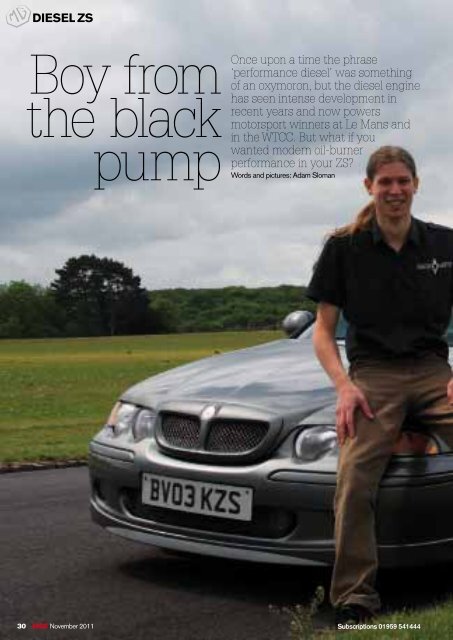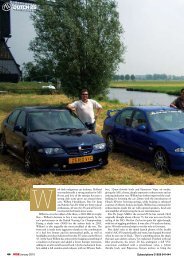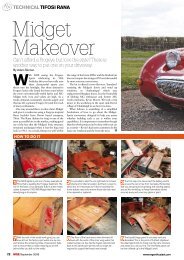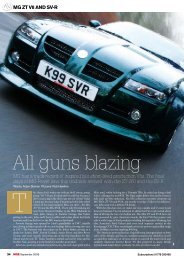Modified MG ZS diesel - Adam Sloman
Modified MG ZS diesel - Adam Sloman
Modified MG ZS diesel - Adam Sloman
Create successful ePaper yourself
Turn your PDF publications into a flip-book with our unique Google optimized e-Paper software.
DIESEL <strong>ZS</strong><br />
Boy from<br />
the black<br />
pump<br />
Once upon a time the phrase<br />
‘performance <strong>diesel</strong>’ was something<br />
of an oxymoron, but the <strong>diesel</strong> engine<br />
has seen intense development in<br />
recent years and now powers<br />
motorsport winners at Le Mans and<br />
in the WTCC. But what if you<br />
wanted modern oil-burner<br />
performance in your <strong>ZS</strong>?<br />
Words and pictures: <strong>Adam</strong> <strong>Sloman</strong><br />
30 <strong>MG</strong>E November 2011<br />
Subscriptions 01959 541444
hen the <strong>ZS</strong> launched in 2001, the range<br />
W<br />
included a <strong>diesel</strong>, the 115bhp L-series<br />
Turbo <strong>diesel</strong>. This made perfect sense<br />
because while <strong>MG</strong> and <strong>diesel</strong> power may<br />
not have an extensive history together,<br />
<strong>diesel</strong> engines have seen increasing use in<br />
cars with a sporting intent, especially<br />
since the dawn of the new millennium.<br />
And it worked – a mix of sporty driving characteristics and<br />
<strong>diesel</strong> frugality gave the <strong>ZS</strong> <strong>diesel</strong> a broad appeal, and it has<br />
even become popular with enthusiasts thanks to its tunability.<br />
29 year old Pete Cowlishaw is one of those enthusiasts. He<br />
got his first taste of <strong>MG</strong> during a Racing Experience day at<br />
Thruxton Circuit and, having driven a V6 <strong>ZS</strong>180, he was<br />
hooked. ‘It was great,’ he says of that memory. ‘I loved the way<br />
it drove and I wanted one straight away. I’d considered a <strong>diesel</strong><br />
SEAT Leon and a petrol Toyota Celica, but the <strong>MG</strong> was what I<br />
wanted. I very nearly bought a V6 180, but at the time there<br />
was no way I could insure it. Plus, I cover a lot of miles for<br />
work and I wasn’t keen on the petrols.’<br />
Pete’s age, combined with that high-mileage career<br />
developing and installing software for pharmaceutical<br />
companies, meant he had to look at a more economical <strong>ZS</strong>,<br />
and the <strong>diesel</strong> fitted the bill perfectly. And while some younger<br />
motorists are content to simply swap a set of wheels or perhaps<br />
add a body kit, Pete has forgone the styling tweaks in order to<br />
concentrate only on improving the performance and<br />
driveability of his <strong>MG</strong>. ‘I got the car as a 22nd birthday<br />
present,’ he recalls. ‘That was in 2004, and the <strong>ZS</strong> was just nine<br />
months old. I had to wait a while for the insurance to become a<br />
bit more reasonable before I could start to modify it.’<br />
Pete’s first changes saw him swap the air filter, fit a de-cat<br />
pipe to the exhaust system and up the turbo’s boost to 19psi. (If<br />
that sounds unreasonably high to those more accustomed to<br />
Below: Pete<br />
Cowlishaw<br />
wanted an <strong>MG</strong><br />
that was fast and<br />
fun, but it also<br />
had to be long<br />
legged and frugal.<br />
www.mgenthusiast.com<br />
November 2011 <strong>MG</strong>E<br />
31
DIESEL <strong>ZS</strong><br />
Above: Pete’s <strong>ZS</strong><br />
manages to look<br />
surprisingly edgy<br />
without the<br />
benefit of trick<br />
paint or lairy<br />
body kits.<br />
Right: Diesels are<br />
built to take<br />
heady pressures,<br />
and 19psi of<br />
boost equates to<br />
a shade over 1.3<br />
bar on the gauge.<br />
Right: Scangauge<br />
connects to the<br />
OBDII port and<br />
shows info such<br />
as coolant and air<br />
intake temps and<br />
fuel consumption.<br />
petrol engines, bear in mind that the L-series in standard trim<br />
should run at 16psi.) After some research amongst the owners’<br />
community, Pete found 19psi was as high as the boost could go<br />
safely. While it didn’t make the <strong>MG</strong> massively quicker, Pete<br />
says the cars driveability improved no end. ‘A friend had taken<br />
me out in his modified L-series Rover 400. It was a cracking<br />
car, dyno’d at around 165bhp with 240lb.ft of torque, while<br />
still giving decent economy if it was sensibly driven. Seeing<br />
what could be done really inspired me. He said he’d spent<br />
around £2000 on parts, and the return for that looked good. I<br />
budgeted up to £4000, but soon passed that.’<br />
A promotion in 2007 meant Pete was able to put a bit more<br />
money into the project, and it began in earnest. Initially he had<br />
the <strong>ZS</strong> gearbox rebuilt and a Quaife ATB differential together<br />
with an uprated clutch fitted. ‘The PG1 gearbox cannot cope<br />
with much more torque than about 250lb.ft,’ he explained. ‘A<br />
popular modification across the forums is to pop some steel<br />
caged bearings in there when they start changing clutches, and<br />
after speaking to a few people in the Rover tuning scene, I<br />
decided it was a sensible thing to do to extend the life of my<br />
gearbox. The modified Rover I had ridden in had a Torsen diff,<br />
and I really felt the torque steer pulling at the wheels until the<br />
diff kicked in and straightened it out. Putting the Quaife diff in<br />
mine meant I could keep the power down – this has transformed<br />
the handling to the point where I can keep my foot firmly<br />
planted as I corner or change direction.’<br />
Pete then sourced a Stage 2 hybrid turbo, which uses a<br />
standard <strong>ZS</strong> <strong>diesel</strong> housing, but is machined out to take the<br />
biggest turbines possible – the compressor side from a Land<br />
Rover TD5 and the exhaust side from a SAAB. The car was<br />
then sent to Matt Stevens (aka Rally Matt) who fitted the<br />
turbo, gearbox and injectors. ‘The car was really smokey,’ says<br />
Pete. ‘The car was driveable, but you had to be gentle pulling<br />
off before the turbo spooled up, and if you put your foot flat to<br />
the floor, you would obscure cars in the rear view mirror.’<br />
The reason for the <strong>ZS</strong>’ smoking habit was eventually traced<br />
to faulty fuel injectors. ‘They were made up by a chap on the<br />
32 <strong>MG</strong>E November 2011<br />
Subscriptions 01959 541444
<strong>MG</strong>Rover.org forum, and no-one really knows what<br />
specification they are. They should not have produced the<br />
levels of smoke that I saw.’ The <strong>ZS</strong> returned to Matt Reidy’s<br />
workshop, who reduced the fuel levels, but to little effect. ‘We<br />
still had exhaust gas temperatures in excess of 850°C at full<br />
throttle! I decided to get rid of those injectors and fit the current<br />
ones. The result was 50lb.ft of extra torque at 2500rpm instead<br />
of 3000rpm, and 10bhp up top. More significantly, there was<br />
next to no smoke when on the road.’<br />
With things far from ideal in terms of emissions, the car then<br />
suffered a head-gasket failure. ‘There was no mayo like you see<br />
on a K-series when oil and water mix,’ Pete says. Instead it<br />
suffered from head lift, which is when the cylinder pressures get<br />
so high that they force the head up a touch and allow the<br />
exhaust gases to get into the coolant galleries.’ While he was<br />
repairing this, Pete had the head ported and sourced a set of<br />
head bolts used on the American NASCAR racers, while the<br />
fasteners come from a Subaru Impreza WRX.<br />
The head gasket failure meant Pete was now considering<br />
other modifications too. ‘I spoke to Matt at length; one area we<br />
talked about was the intercooler. Matt felt the car could do<br />
with something more substantial, since the original <strong>MG</strong> Rover<br />
one isn’t all that great.’ With the exhaust manifold showing<br />
temperatures of 850°C, Pete was inclined to agree. Matters<br />
came to a head when a boost leak from the intercooler caused<br />
him to think his custom turbo had failed, which led to a further<br />
chat with Matt. ‘Most people use older injectors from the<br />
Rover SD1, but I combined the original ones from the <strong>ZS</strong> with<br />
older Rover 200 ones,’ he explained. Matt then worked out the<br />
most efficient way to route the pipework to the intercooler<br />
before I sat down with a Demon Tweeks catalogue and started<br />
ordering the necessary parts.’<br />
By early 2010 the car was ready for a remap, which showed<br />
that it was peaking at only 130bhp. A new MAF (mass airflow<br />
meter) meant an additional 10lb.ft of torque and another<br />
5bhp, but as Pete says: ‘It wasn’t much of an improvement, to<br />
be honest. The problem is the ECU restricts everything. Matt<br />
www.mgenthusiast.com<br />
then suggested upping the voltage to the fuel pump in order to<br />
improve the fuel’s flow rate.’ It worked. The next time the <strong>ZS</strong><br />
hit the rollers it was showing a healthy 170bhp and an<br />
impressive 269lb.ft of torque. ‘I wanted a nice, flat torque curve<br />
and I got it!’ Pete says with a grin.<br />
Things didn’t last quite as long as Pete had hoped though, as<br />
another head gasket failure was just around the corner. ‘I got a<br />
bit over-enthusiastic with it and blew it again. Thankfully I was<br />
able to replace the lost coolant and nurse it back home, driving<br />
with a five litre bottle of water on the seat next to me.’ After a<br />
bit of investigation, Pete found that any time the <strong>ZS</strong> was driven<br />
with any vigour, it lost coolant. The water loss was soon traced<br />
to a broken thermostat and a water pump that was past its<br />
best. ‘The water pump was replaced, and I worked with Matt<br />
to develop a pressure reader on the exhaust manifold, which<br />
we thought might be causing the head gasket problems.’<br />
Working on a process of elimination, Pete and Matt worked<br />
out that the turbo’s housing was too small and restricted gas<br />
flow. ‘The wastegate wasn’t up to dealing with the volume of<br />
gas passing through it; we hooked up a standard boost gauge<br />
to read the pressure and it was off the scale.’ After such<br />
significant investment in his hybrid turbo, Pete is keen to retain<br />
it and to look at other ways to lower pressure on the wastegate.<br />
Deciding to try out an external waste gate, a prototype was<br />
built up from copper piping, but proved unsuccessful. ‘It was<br />
melted by the exhaust after 500 miles and was un-silenced, so it<br />
was extremely noisy.’ So the next step will be for Matt to<br />
fabricate a stainless steel version, with an external wastegate<br />
Above: Diesels<br />
don’t feature in<br />
<strong>MG</strong>E often, but in<br />
this millennium<br />
they have rock<br />
solid sporting<br />
credentials.<br />
“The cylinder pressures got so<br />
high that the head lifted and<br />
exhaust gas got into the coolant”<br />
November 2011 <strong>MG</strong>E 33
DIESEL <strong>ZS</strong><br />
Above: Pete<br />
started his <strong>ZS</strong><br />
project with track<br />
days in mind, and<br />
it may yet veer in<br />
that direction. But<br />
for now...<br />
running off a pressure sensor in the tubing and with a restrictor<br />
plate to reduce the surge in case too much gas goes astray.<br />
When they get the external waste gate working, it’ll need to be<br />
plumbed into the exhaust system or it will be way too loud.<br />
So after an investment of over £10,000 and plenty of blood,<br />
sweat and tears, is Pete’s <strong>ZS</strong> finished? ‘When I get the car to the<br />
point where I can drive it flat out without it breaking, then it<br />
will be done. I could get a larger turbo, but that would mean<br />
more development work. Once I have got reliability, I may<br />
consider that route, but I am not going to pursue it just yet. I<br />
don’t think I will change the car much anyway – it would take it<br />
over 200bhp and give even more torque than it is currently<br />
running, but I don’t exactly need that level of performance.’<br />
Pete’s project focus has changed as the car has developed and<br />
although the goal posts have shifted, he’s still very happy with<br />
the results of his efforts. ‘I originally started this to make it a<br />
track car,’ he confides, ‘so maybe in time it will get stripped and<br />
lowered and made more track focused, but for now I am happy<br />
with it getting me from A to B quickly. Mind you, the day I use<br />
“A wastegate was made<br />
out of copper pipe, but it<br />
was melted by the<br />
exhaust after 500 miles”<br />
full throttle again will be the day I grin like a kid. It will really<br />
live up to the description that Matt gave it when he likened<br />
driving it to a Windsor chair with an ASBO!’<br />
Pete wishes to thank Matt Stephens (TopStar Sport &<br />
Racing, 0844 822 7012) for all his work, Matt Reidy (Reidy<br />
Remaps, www.reidyremaps.co.uk) and Steve Dobson<br />
(www.stevescleenz.co.uk) for his cleaning wizardry.<br />
Right: ...after all<br />
the changes that<br />
have gone under<br />
the skin, it is time<br />
to take stock and<br />
let the <strong>ZS</strong> prove<br />
its reliability.<br />
34 <strong>MG</strong>E November 2011<br />
Subscriptions 01959 541444







